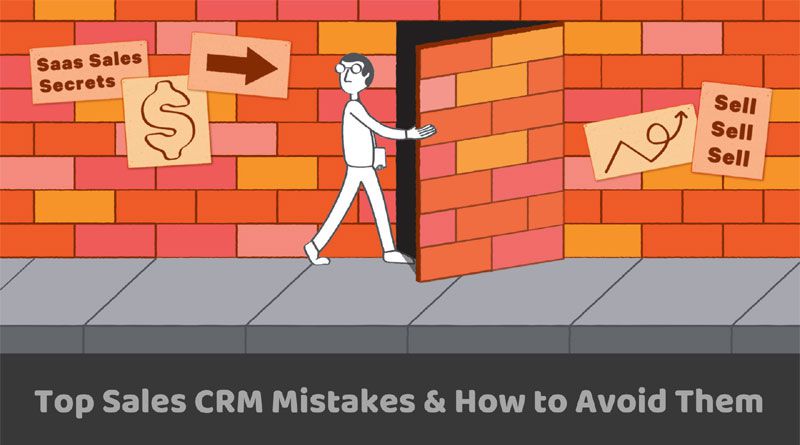With a customer relationship management solution, the idea is to maximize leverage for sales and marketing teams while reducing hassle. While customer relationship management systems have been around for a long time, choosing the right software and configuring it to meet your needs can still be tricky.
Selecting the wrong fit or making deployment mistakes can cost you dearly and leave you worse off than when you started.
To help managers improve their odds of success with CRM, we have compiled a list of the top CRM mistakes and how you can navigate setting up a CRM to avoid blowing up your money and efforts.
Outlining the Top CRM Mistakes
Beginning without end-user buy-in
Before you ever look at a system, you should get the end users involved. Including the end users of a system early on in the process can help you direct efforts toward their needs. If you get a CRM system set up and the users don’t relate to it, it will be as good as nothing. Explain to the users how a CRM will benefit them and get early buy-in from them to ensure they are on the same page as the top level executives.
Ignoring sales teams
One of the top issues with CRM systems is getting sales representatives to use them. This can be solved by listening to what the sales teams need in the right solution. Traditionally, CRM systems were designed to be desktop-only- thus not being a good fit for the sales rep who is always on the go. To see higher user engagement, businesses must get CRM systems developed for mobile usage. This will facilitate real-time updates for sales reps, scheduling and tracking capabilities on the fly, meaning great value to them and their teams.
Choosing a CRM that’s not future-ready
Only a few CRM systems are future-proof. When we say that, we mean they have built-in capabilities for analytics, business intelligence, AI, ML, and so on. Microsoft Dynamics CRM is one such solution. With integrated analytics and reporting capabilities, your teams get improved visibility into the organization, helping them plan functions efficiently.
Picking a non-scalable CRM
Organizations grow and evolve. If a CRM system cannot accommodate your internal growth and expansion, it is already headed toward uselessness. Businesses should never choose CRM systems ‘in-the-moment’. Since these software solutions are a life-long commitment, they should be scalable and easy to evolve as your enterprise does.
Not integrating your CRM internally
A customer relationship management system cannot be a standalone solution. To maximize the ROI out of your CRM solution, you need to integrate it with several internal systems. Companies who integrate their CRM with their email, for example, gain far more in terms of revenue than those who don’t.
Having no defined customer life cycle
Sure, a CRM system can manage your contacts and leads at one place. But, to use it only for that is a huge mistake. A dynamics CRM must be leveraged for its entire potential, which lies in grouping customer information, running analytics, reporting results, and integrating systems. Anything less than that would mean underutilization of a CRM solution.
Too much information
Often, companies get so excited with a CRM system that they try to gather everything they can about their leads and customers under the impression that it might come of use someday. Then, as months roll by, they realize a lot of the data in their system has no practical leverage. To avoid this expensive mistake, only gather data that is absolutely necessary and a value-add for you.
Too many features
Often, companies get in haste to deploy and use their CR system so that they don’t spend enough time figuring out the best features for their business. They install a lot more than they need. This confuses and intimidates users who are unfamiliar with the system. To increase adoption of CRM within your enterprise, you need to lay down a systematic plan that iteratively delivers value and delivers high value in a short period.
Not measuring enough
In order to learn about your progress with CRM, you need to define critical metrics and measure them continuously. There should be well-defined metrics for each business area so that it is easy to gauge how well your Microsoft dynamics CRM services is working for you. These metrics should be tracked regularly. Companies that don’t know what they are trying to optimize and maximize don’t get the right ROI from their CRM solutions.
Dirty Data
If you enter dirty data into your CRM system, your end user will receive insights that are broken. When they make decisions on those insights, they will steer efforts in the wrong direction. Since data is the foundation for a CRM system, strive to be aware of the cleanliness and relevance of your data. If your sales team can’t trust your system, they will be quick to drop it and go back to traditional ways!
The top CRM mistakes are avoidable. Take the right steps and move forward in growing your business and making it a success. Microsoft Dynamics CRM is laden with a host of features that can improve your productivity, efficiency, and help you maximize revenue and profit. Consult a Microsoft Dynamics CRM services partner today!

Namaste UI collaborates closely with clients to develop tailored guest posting strategies that align with their unique goals and target audiences. Their commitment to delivering high-quality, niche-specific content ensures that each guest post not only meets but exceeds the expectations of both clients and the hosting platforms. Connect with us on social media for the latest updates on guest posting trends, outreach strategies, and digital marketing tips. For any types of guest posting services, contact us on info[at]namasteui.com.

